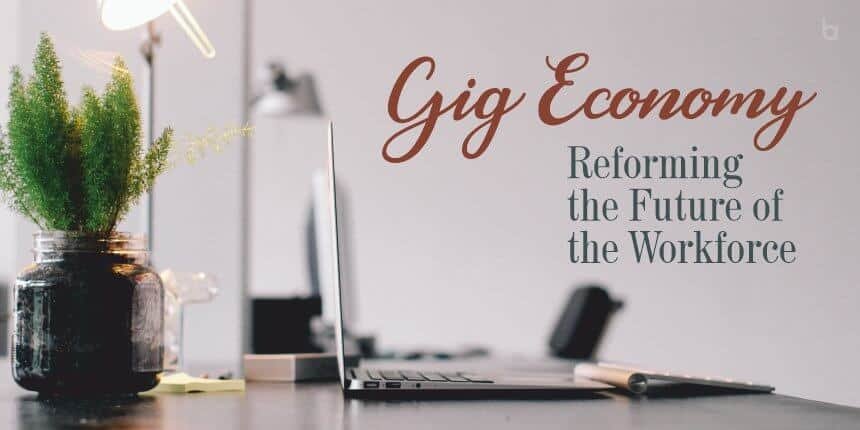With the advent of smartphone technology and increased use of the internet, more avenues have opened. This resulted in both individuals and companies to become more open towards the idea of hiring someone as a freelancer. The term ‘gig economy’ is not a new concept, but this past decade has seen it expand greatly. According to Intuit, the percentage of Americans in the gig economy was 34% in 2016 and is expected to grow to 43% by 2020. Consulting firm McKinsey says that there are currently around 68 million freelancers or self-employed in the US, with around 4 million Americans providing work through gig marketplaces like Lyft or Airbnb. Moreover, there are an ever-increasing number of companies outsourcing their work to flexible, expert, and non-payroll workers. These factors and statistics are indicating that there will be a growth of an agile workforce in the upcoming future.
Now, let’s grasp its definition and how does it work?
What is the gig economy?
The catchword ‘gig economy’ refers to an environment in which individuals work for short-term or temporary, for one or a variety of employers. This economy differs from traditional employment, as the jobs are not permanent. The key aim of people who are working in this area is to earn extra income. These people have statuses such as freelancers, temporary workers, and contract workers. According to the American Staffing Association, the majority of Americans (78%) see the gig economy as a modern way of describing the presence of this long-standing independent workforce. However, on a global scale, they are experiencing both the positive and negative consequences of this economy.
How does it work?
Irrespective of industry or sector, a gig economy comprises of small tasks that the worker completes. These tasks can range from getting groceries to writing code to writing/editing articles. A gig worker can have the option to choose the number of hours (such as choosing a shift) as well as a place to work from. Once the task/project is accomplished, they move to the next gig. A gig (an individual task, assignment, or job) signifies a small portion of a freelance worker’s income. Moreover, this income can be similar to that of a full-time employee’s payment.
Gig economy pros and cons
Freelancers have a variety of pros while working in the gig economy. Following are some of them:
The flexibility of work: Freelance workers have the complete freedom and flexibility to work from a remote office or from home. When a task is allocated, it is up to the worker to select his/her working hours and place where he/she wants to work. This great flexibility attracts people who are trying to work around family schedules or want to earn extra cash.
Boost Independence: The gig workers receive no pressure from managers or high-ups to complete their allocated tasks. This resulted in boosting their confidence and independence as well as completing a job the way they believe it will be best done—on their timetable and in their way.
Pay: The wage of any task completed by an independent contractor depends upon the company they are working for. Several businesses pay contractor employees less, while many pay their workers more because they do not have to pay benefits as well as salaries. They are often able to charge their time for the hourly rates. As a result, freelance workers can control their work hours and get paid for extra hours on the clock.
A wide range of jobs: The gig economy workers get the chance to work on different projects rather than working on similar projects. Because of this, they are excited to be more creative with their work. They also get to experience different things and enhance their skills.
Despite having quite a few pros, the gig economy also has downsides that make it difficult:
No benefits packages: Since the independent workforce is not a full-time employee of the organization, they don’t receive any benefits packages. As a result, they have to formulate a proper plan for saving and retirement. Investing is another great option for them to increase their financial status.
Focus on personal expenses: As above-mentioned, the freelance worker is not full-time employees. So, they are responsible for their personal expenses associated with working such as laptops and cell phones. Although these can be written off for taxes, it is equally important to focus on what they want to deduct. Many freelancers find it best to work with an accountant so they can go over all the things they use for their work and know what to write-off for their taxes.
Isolation from others: A full-time employee gets to party and celebrate, interact with other employees, and attend the team meeting, etc., whereas a temporary worker does not go to the office and miss on the social elements present there. Even though they have flexibility, but it is causing them isolated from others.
Increase stress level: Often gig economy workers face unexpected changes in their careers, including being let go or a shift in their pay. Also, finding their next gig or be ready for changes in the current one, add fuel to their stress level.
Ultimately, the gig economy is the best place for those people who want freedom, flexibility, and extra income. However, those who solely rely on it need to constantly search for work resulting in a nightmare for them. So, the alternative solution can be to make full-time employment more flexible, thereby allowing full employees the freedom to work when and where they like without the risk of going hungry or homeless. More importantly, the gig economy is here to stay despite whether people loathe it or not.
References:
- https://www.wonolo.com/blog/what-is-the-gig-economy/
- https://www.wgu.edu/blog/pros-and-cons-gig-economy1808.html
- https://www.forbes.com/sites/charlestowersclark/2019/07/08/the-uberization-of-work-pros-and-cons-of-the-gig-economy/#57f08f281cc7
- https://www.wonolo.com/blog/data-gig-economy-transforming-workforce/















